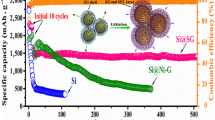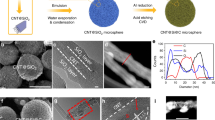Abstract
Nanostructured silicon has generated significant excitement for use as the anode material for lithium-ion batteries; however, more effort is needed to produce nanostructured silicon in a scalable fashion and with good performance. Here, we present a direct preparation of porous silicon nanoparticles as a new kind of nanostructured silicon using a novel two-step approach combining controlled boron doping and facile electroless etching. The porous silicon nanoparticles have been successfully used as high performance lithium-ion battery anodes, with capacities around 1,400 mA·h/g achieved at a current rate of 1 A/g, and 1,000 mA·h/g achieved at 2 A/g, and stable operation when combined with reduced graphene oxide and tested over up to 200 cycles. We attribute the overall good performance to the combination of porous silicon that can accommodate large volume change during cycling and provide large surface area accessible to electrolyte, and reduced graphene oxide that can serve as an elastic and electrically conductive matrix for the porous silicon nanoparticles.
Graphical abstract

Similar content being viewed by others
References
Obrovac, M. N.; Christensen, L. Structural changes in silicon anodes during lithium insertion/extraction. Electrochim. Solid-State Lett. 2004, 7, A93–A96.
Zhou, S.; Liu, X. H.; Liu, Wang, D. W. Si/TiSi2 heteronanostructures as high-capacity anode material for Li ion batteries. Nano Lett. 2010, 10, 860–863.
Peng, K. Q.; Jie, J. S.; Zhang, W. J.; Lee, S. T. Silicon nanowires for rechargeable lithium-ion battery anodes. Appl. Phys. Lett. 2008, 93, 033105.
Chan, C. K.; Patel, R. N.; O’Connell, M. J.; Korgel, B. A.; Cui, Y. Solution-grown silicon nanowires for lithium-ion battery anodes. ACS Nano 2010, 4, 1443–1450.
Chan, C. K.; Peng, H. L.; Liu G.; McIlwrath, K.; Zhang, X. F.; Huggins, R. A.; Cui, Y. High-performance lithium battery anodes using silicon nanowires. Nat. Nanotechnol. 2008, 3, 31–35.
Park, M.-H.; Kim, M. G.; Joo, J.; Kim, K.; Kim, J.; Ahn, S.; Cui, Y.; Cho, J. Silicon nanotube battery anodes. Nano Lett. 2009, 9, 3844–3847.
Song, T.; Xia, J. L.; Lee, J.-H.; Lee, D. H.; Kwon, M.-S.; Choi, J.-M.; Wu, J.; Doo, S. K.; Chang, H.; Park, W. et al. Arrays of sealed silicon nanotubes as anodes for lithium ion batteries. Nano Lett. 2010, 10, 1710–1716.
Qu, Y. Q.; Liao, L.; Li, Y. J.; Zhang, H.; Huang, Y.; Duan, X. F. Electrically conductive and optically active porous silicon nanowires. Nano Lett. 2009, 9, 4539–4543.
Magasinski, A.; Dixon, P.; Hertzberg, B.; Kvit, A.; Ayala, J.; Yushin, G. High-performance lithium-ion anodes using a hierarchical bottom-up approach. Nat. Mater. 2010, 9, 353–358.
Kim, H.; Han, B.; Choo, J.; Cho, J. Three-dimensional porous silicon particles for use in high-performance lithium secondary batteries. Angew. Chem. Int. Ed. 2008, 47, 10151–10154.
Yao, Y.; McDowell, M. T.; Ryu, I.; Wu, H.; Liu, N. A.; Hu, L. B.; Nix, W. D.; Cui, Y. Interconnected silicon hollow nanospheres for lithium-ion battery anodes with long cycle life. Nano Lett. 2011, 11, 2949–2954.
Ge, M.; Rong, J.; Fang, X.; Zhou, C. Porous doped silicon nanowires for lithium ion battery anode with long cycle life. Nano Lett. 2012, 12, 2318–2323.
Chen, X. L.; Gerasopoulos, K.; Guo, J. C.; Brown, A.; Ghodssi, R.; Culver, J. N.; Wang, C. S. High rate performance of virus enabled 3D n-type Si anodes for lithium-ion batteries. Electrochim. Acta 2011, 56, 5210–5213.
Lu, X. M.; Hanrath, T.; Johnston, K. P.; Korgel, B. A. Growth of single crystal silicon nanowires in supercritical solution from tethered gold particles on a silicon substrate. Nano Lett. 2003, 3, 93–99.
Holmes, J. D.; Johnston, K. P.; Doty, R. C.; Korgel, B. A. Control of thickness and orientation of solution-grown silicon nanowires. Science 2000, 287, 1471–1473.
Kovalenko, I.; Zdyrko, B.; Magasinski, A.; Hertzberg, B.; Milicev, Z.; Burtovyy, R.; Luzinov, I.; Yushin, G. A major constituent of brown algae for use in high-capacity Li-ion batteries. Science 2011, 334, 75–79.
Lin, V. S.-Y.; Motesharei, K.; Dancil, K. P. S.; Sailor, M. J.; Ghadiri, M. R. A porous silicon-based optical interferometric biosensor. Science 1997, 278, 840–843.
Hochbaum, A. I.; Gargas, D.; Hwang, Y. J.; Yang, P. D. Single crystalline mesoporous silicon nanowires. Nano Lett. 2009, 9, 3550–3554.
Tang, J. Y.; Wang, H.-T.; Lee, D. H.; Fardy, M.; Huo, Z.; Russell, T. P.; Yang, P. D. Holey silicon as an efficient thermoelectric material. Nano Lett. 2010, 10, 4279–4283.
Peng, K. Q.; Hu, J. J.; Yan, Y. J.; Wu, Y.; Fang, H.; Xu, Y.; Lee, S.-T.; Zhu, J. Fabrication of single-crystalline silicon nanowires by scratching a silicon surface with catalytic metal particles. Adv. Funct. Mater. 2006, 16, 387–394.
Peng, K.; Lu, A.; Zhang, R. Lee, -S. Motility of metal nanoparticles in silicon and induced anisotropic silicon etching. Adv. Funct. Mater. 2008, 18, 3026–3035.
Patterson, A. L. The Scherrer formula for X-ray particle size determination. Phys. Rev. 1939, 56, 978–982.
Silva, J. A.; Brito, M. C.; Costa, I.; Alves, J. M.; Serra, J. M.; Vallêra, A. M. Sprayed boric acid as a dopant source for silicon ribbons. Sol. Energy Mater. Sol. Cells 2007, 91, 1948–1953.
Chan, C. K.; Ruffo, R.; Hong, S. S.; Huggins, R. A.; Cui, Y. Structural and electrochemical study of the reaction of lithium with silicon nanowires. J. Power Sources 2009, 189, 34–39.
Lee, J. K.; Smith, K. B.; Hayner, C. M.; Kung, H. H. Silicon nanoparticles-graphene paper composites for Li ion battery anodes. Chem. Commun. 2010, 46, 2025–2027.
Liu, Y.; Chen, B.; Cao, F.; Chen, H. L. W.; Zhao, X.; Yuan, J. One-pot synthesis of three-dimensional silver-embedded porous silicon micronparticles for lithium-ion batteries. J. Mater. Chem. 2011, 21, 17083–17086.
Author information
Authors and Affiliations
Corresponding author
Electronic supplementary material
Rights and permissions
About this article
Cite this article
Ge, M., Rong, J., Fang, X. et al. Scalable preparation of porous silicon nanoparticles and their application for lithium-ion battery anodes. Nano Res. 6, 174–181 (2013). https://doi.org/10.1007/s12274-013-0293-y
Received:
Revised:
Accepted:
Published:
Issue Date:
DOI: https://doi.org/10.1007/s12274-013-0293-y




